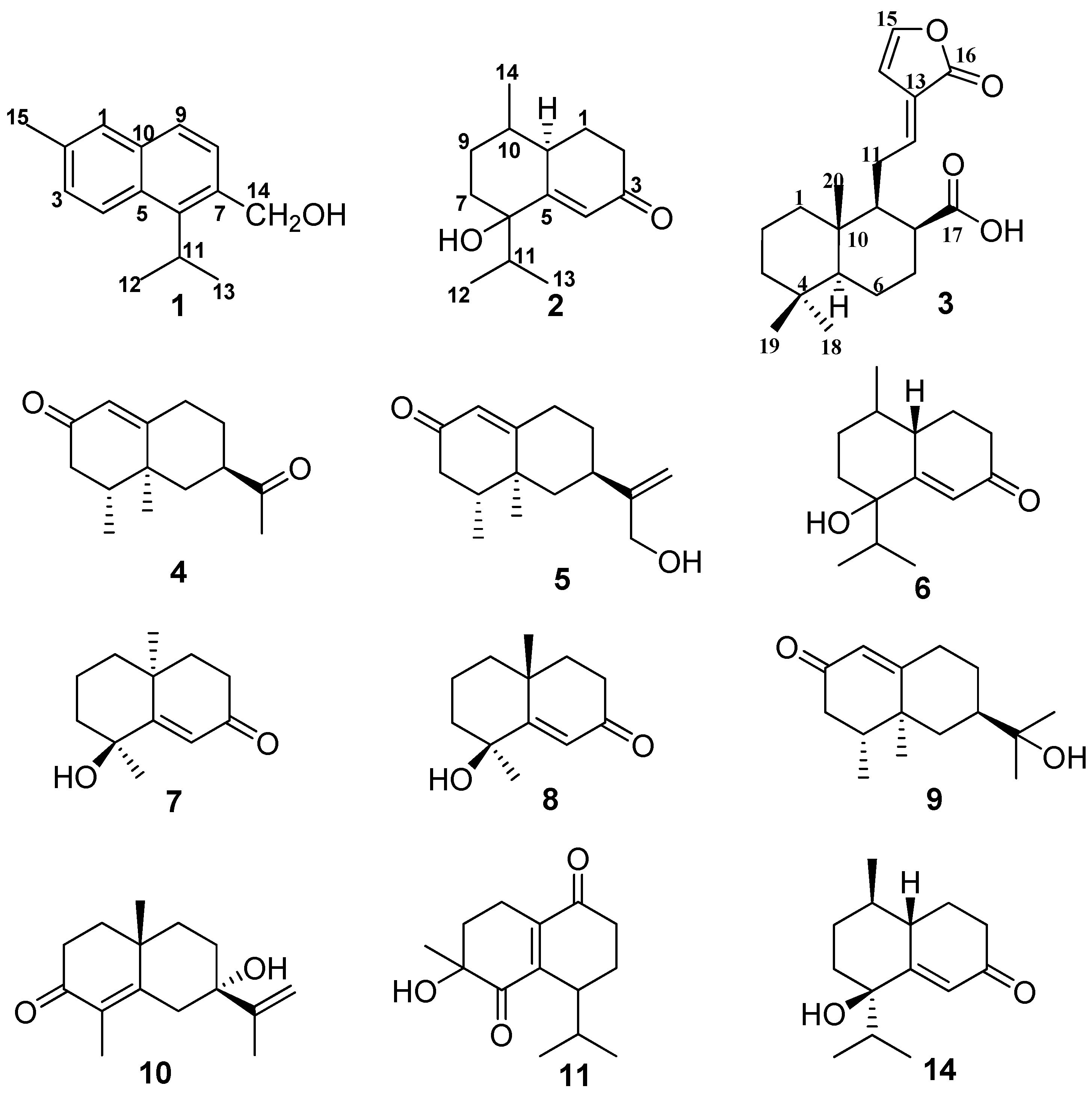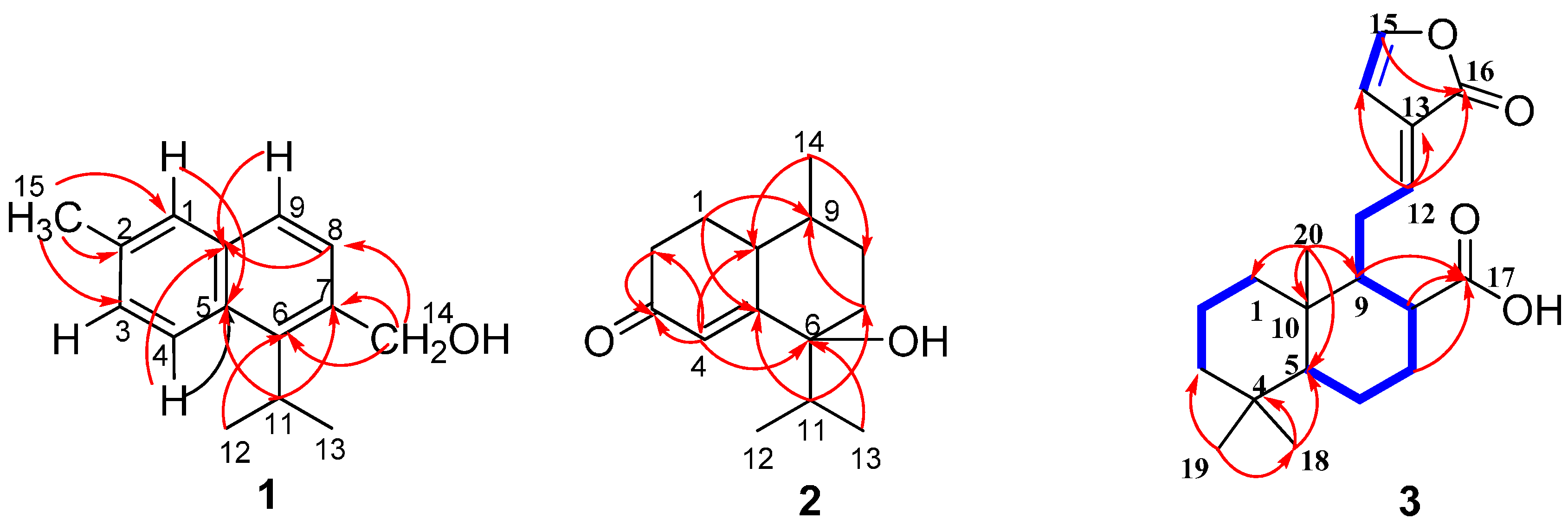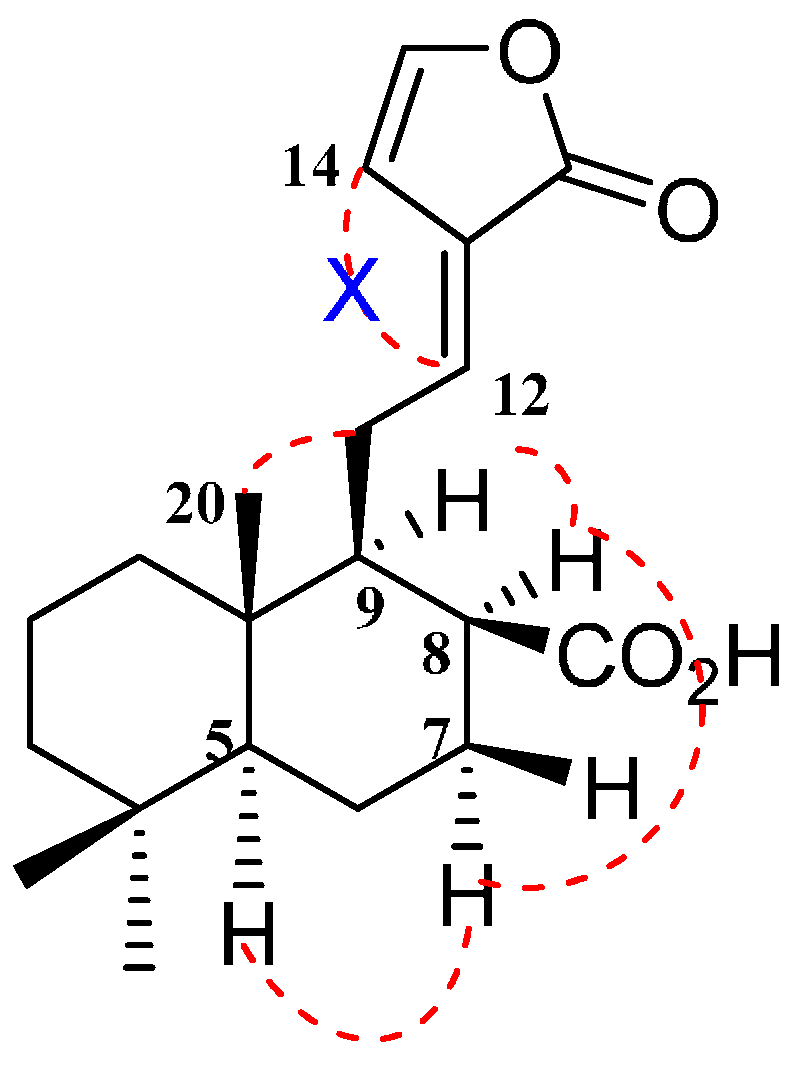New Sesquiterpenoids and a Diterpenoid from Alpinia oxyphylla
Abstract
:1. Introduction

2. Results and Discussion

| No. | 1(MeOD) | 2(CDCl3) | 3(CDCl3) | 6(CDCl3) |
|---|---|---|---|---|
| δH (J in Hz) | δH (J in Hz) | δH (J in Hz) | δH (J in Hz) | |
| 1 | 7.95, s | 1ɑ, 1.74, m | 1ɑ, 1.50, m | 1ɑ, 1.79, m |
| 1β, 2.23, m | 1β, 1.79, m | 1β, 2.17, m | ||
| 2 | 2ɑ, 2.26, m | 2ɑ, 1.37, m | 2ɑ, 2.28, m | |
| 2β, 2.38, m | 2β, 1.55, m | 2β, 2.42, m | ||
| 3 | 7.37, d (7.8) | 1.10, 1H,m,3ɑ | ||
| 1.28, 1H,m,3β | ||||
| 4 | 7.35, d (7.8) | 6.23, s | 5.94, s | |
| 5 | 0.97, dd (13.2, 2.4) | |||
| 6a | 1.81, m | |||
| 6b | 1.61, m | |||
| 7a | 7a, 2.16, m | 1.20, m | 7a, 1.93, m | |
| 7b | 7b, 1.40, m | 2.19, m | 7b, 1.40, m | |
| 8 | 7.41, d (8.4) | 8a, 1.66, m | 2.43, s | 8a, 1.61, m |
| 8b, 1.71, m | 8b, 1.63, m | |||
| 9 | 8.05, d (8.4) | 1.46, m | 1.83, d (12.6) | 1.43, m |
| 10 | 2.00, m | 2.47, m | ||
| 11a | 3.75, h (6.6) | 2.08, m | 2.80, br.d, (12.6) | 2.14, m |
| 11b | 2.62, br.t, (12.6) | |||
| 12 | 1.38, d (6.6) | 0.99, d (6.0) | 7.95, s | 1.00, d (6.6) |
| 13 | 1.38, d (6.6) | 0.75, d (6.0) | 0.94, d (6.6) | |
| 14 | 5.01, s | 1.05, d (6.0) | 7.74, d (6.0) | 1.05, d (6.6) |
| 15 | 2.54, s | 6.37, d (6.0) | ||
| 18 | 0.82, s | |||
| 19 | 0.84, s | |||
| 20 | 0.90, s |
| No. | 1(MeOD) | 2(CDCl3) | 3(CDCl3) | 6(CDCl3) |
|---|---|---|---|---|
| δC | δC | δC | δC | |
| 1 | 124.1, CH | 26.3, CH2 | 39.2, CH2 | 25.6, CH2 |
| 2 | 136.3, C | 35.4, CH2 | 18.9, CH2 | 35.1, CH2 |
| 3 | 128.7, CH | 199.9, C | 42.1, CH2 | 200.9, C |
| 4 | 122.4, CH | 122.5,CH | 33.6, C | 122.9,CH |
| 5 | 135.8, C | 170.1, C | 56.4, CH | 168.2, C |
| 6 | 145.4, C | 76.7, C | 19.3, CH2 | 76.0, C |
| 7 | 131.6, C | 37.9, CH2 | 29.6, CH2 | 33.7, CH2 |
| 8 | 125.6, CH | 31.1, CH2 | 39.9, CH | 29.7, CH2 |
| 9 | 125.7, CH | 39.1, CH | 52.7, CH | 38.2, CH |
| 10 | 133.4, C | 42.0, CH | 39.1, C | 40.9, CH |
| 11 | 29.7, CH | 30.7, CH | 22.7, CH2 | 32.9, CH |
| 12 | 24.2, CH3 | 15.5, CH3 | 155.0, CH | 16.9, CH3 |
| 13 | 24.2, CH3 | 16.4, CH3 | 129.9, C | 18.0, CH3 |
| 14 | 63.8, CH2 | 20.1, CH3 | 155.4, CH | 20.3, CH3 |
| 15 | 22.2, CH3 | 117.0, CH | ||
| 16 | 179.7, C | |||
| 17 | 179.7, C | |||
| 18 | 33.6, CH3 | |||
| 19 | 21.6, CH3 | |||
| 20 | 14.4, CH3 |

3. Experimental Section
3.1. General Experimental Procedures
3.2. Plant Material
3.3. Extraction and Isolation
3.4. Inhibitory Activity on Glucosidase
4. Conclusions
Acknowledgments
Author Contributions
Conflicts of Interest
References
- Chinese Pharmacopoeia Commission. Pharmacopoeia of the People’s Republic of China; China Medical Science and Technology Press: Beijing, China, 2010; Volume 1, p. 274. [Google Scholar]
- Morikawa, T.; Matsuda, H.; Toguchida, I. Absolute stereostructures of three new sesquiterpenes from the fruit of Alpinia oxyphylla with inhibitory effects on nitric oxide production and degranulation in RBL-2H3 cells. J. Nat. Prod. 2002, 65, 1468–1474. [Google Scholar] [CrossRef] [PubMed]
- Lv, X.Q.; Luo, J.G.; Wang, X.B. Four new sesquiterpenoids from the fruits of Alpinia oxyphylla. Chem. Pharm. Bull. 2011, 59, 402–406. [Google Scholar] [CrossRef] [PubMed]
- Luo, J.G.; Lv, X.Q.; Wang, X.B. Sesquiterpenoids from the fruits of Alpinia oxyphylla and inhibition of nitric oxide production in lipopolysaccaride-activated macrophages. Phytochem. Lett. 2012, 5, 134–138. [Google Scholar] [CrossRef]
- Xu, J.J.; Ji, C.J.; Zhang, Y.M. Inhibitory activity of eudesmane sesquiterpenes from Alpinia oxyphylla on production of nitric oxide. Bioorganic Med. Chem. Lett. 2012, 22, 1660–1663. [Google Scholar] [CrossRef]
- Jiang, B.; Wang, W.J.; Li, M.P. New eudesmane sesquiterpenes from Alpinia oxyphylla and determination of their inhibitory effects on microglia. Bioorg. Med. Chem. Lett. 2013, 23, 3879–3883. [Google Scholar] [CrossRef] [PubMed]
- Bhonsle, J.B. Total synthesis of (+)-isozingiberene via a novel and efficient Hoffmann elimination reaction. J. Synth. Commun. 1995, 25, 289–300. [Google Scholar] [CrossRef]
- Mai, F.; Toshihiro, H.; Yoshiaki, N. Biotransformation of citrus aromatics nootkatone and valencene by microorganisms. Chem. Pharm. Bull. 2005, 53, 1423–1429. [Google Scholar] [CrossRef] [PubMed]
- Gliszczynska, A.; Lysek, A.; Janeczko, T. Microbial transformation of nootkatone and the antiproliferative activity of its metabolites. Bioorganic Med. Chem. Lett. 2011, 19, 2464–2469. [Google Scholar] [CrossRef]
- Braulio, M.F.; Melchor, G.H.; Teresa, M. Nor-sesquiterpenes from Teucrium heterophyllum. Phytochemistry 1995, 39, 617–619. [Google Scholar] [CrossRef]
- Cheng, S.Y.; Wang, S.K.; Wen, Z.H. Three new eudesmanoids from the formosan soft coral Nephthea erecta. J. Asian Nat. Prod. Res. 2009, 11, 967–973. [Google Scholar] [CrossRef] [PubMed]
- Savona, G.; Piozzi, F.; De La Torre, M.; Servettaz, O.; Rodriguez, B. A valencane sesquiterpenoid from Teucrium Carolzpauz. Phymchemisrry 1987, 26, 571–572. [Google Scholar] [CrossRef]
- Xu, J.J.; Tan, N.H.; Han, H.J.; Feng, Y.F. Two new norsesquiterpenes from the fruits of Alpinia oxyphylla. Chin. J. Nat. Med. 2010, 8, 6–8. [Google Scholar] [CrossRef]
- Antri, A.E.; Messouri, I.; Tlemçani, R.C. Flavone glycosides from Calycotome Villosa subsp. intermedia. Molecules 2004, 9, 568–573. [Google Scholar] [CrossRef]
- Song, F.H.; Xu, X.L.; Li, S. Norsesquiterpenes from the brown alga Dictyopteris divaricata. J. Nat. Prod. 2005, 68, 1309–1313. [Google Scholar] [CrossRef] [PubMed]
- Akiyama, K.; Kikuzaki, H.; Aoki, T. Terpenoids and a diarylheptanoid from Zingiber ottensii. J. Nat. Prod. 2006, 69, 1637–1640. [Google Scholar] [CrossRef] [PubMed]
- Kang, W.Y.; Zhang, L.; Song, Y.L. α-Glucosidase inhibitors from Luculia pinciana. China J. Chin. Mater. Med. 2009, 34, 406–409. [Google Scholar]
- Sample Availability: Samples of the compounds (1–12) are available from the authors.
© 2015 by the authors. Licensee MDPI, Basel, Switzerland. This article is an open access article distributed under the terms and conditions of the Creative Commons Attribution license ( http://creativecommons.org/licenses/by/4.0/).
Share and Cite
Hou, L.; Ding, G.; Guo, B.; Huang, W.; Zhang, X.; Sun, Z.; Shi, X. New Sesquiterpenoids and a Diterpenoid from Alpinia oxyphylla. Molecules 2015, 20, 1551-1559. https://doi.org/10.3390/molecules20011551
Hou L, Ding G, Guo B, Huang W, Zhang X, Sun Z, Shi X. New Sesquiterpenoids and a Diterpenoid from Alpinia oxyphylla. Molecules. 2015; 20(1):1551-1559. https://doi.org/10.3390/molecules20011551
Chicago/Turabian StyleHou, Lei, Gang Ding, Baolin Guo, Wenhua Huang, Xiaojian Zhang, Zhiyong Sun, and Xiangfen Shi. 2015. "New Sesquiterpenoids and a Diterpenoid from Alpinia oxyphylla" Molecules 20, no. 1: 1551-1559. https://doi.org/10.3390/molecules20011551





